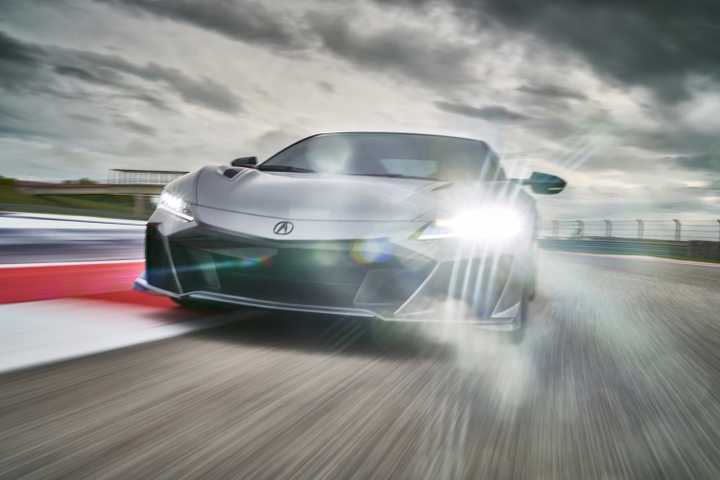The Acura NSX is a moniker that helped the luxury Japanese brand build a considerable amount of street cred when the company introduced it to the global market. The goal was for this striking offering to provide a blend of performance and aspiration comparable to a Ferrari or Lamborghini, but at a much more affordable price. Despite this, Acura never enjoyed considerable success with this product, even when it reintroduced it as a much more expensive and capable HEV some time after its initial discontinuation. While the PHEV NSX may have been a market failure, Acura’s early approach to electrification helps it set a very strong foundation for its upcoming all-electric halo supercar.


- Base Trim Engine
-
3.5L Twin-Turbo V6 Hybrid
- Base Trim Transmission
-
Automatic
- Base Trim Drivetrain
-
All-Wheel Drive
- Base Trim Horsepower
-
600 hp
- Base Trim Torque
-
492 lb-ft
- Fuel Economy
-
21/22 MPG
- Make
-
Acura
- Model
-
NSX
- Segment
-
Supercar
Within the next two to three years, the automotive world is set to see several halo fully electric supercars enter the market, and Acura is no exception. The Honda subsidiary has already teased what we can expect from the new model with its Electric Vision Design Study concept two years ago, with a mild list of expected specifications and performance claims. While we remain excited about this new model that is sure to set a performance benchmark for the brand, we can’t help but acknowledge the importance of the second-generation Acura NSX in setting a solid foundation for this upcoming model, specifically when it comes to its triple electric motor HEV configuration.
To give you the most up-to-date and accurate information possible, the data used to compile this article was sourced from Acura and other authoritative sources, including the EPA and Road and Track.
What Made The Second-Generation NSX So Great
We’d Argue It Was Too Ahead Of Its Time
The second-generation Acura NSX entered specific global markets as a high-performance HEV supercar, featuring the brand’s twin-turbocharged 3.5-liter V-6 mid-mounted engine. This unit produces 500 horsepower and 406 pound-feet of torque to the rear axle in isolation, with a 7,500 RPM redline.
Joining this configuration is a trio of electric permanent-magnet-synchronous motors, two of which are located at the front, driving each wheel independently, with the third located at the rear, next to the nine-speed dual-clutch automatic transmission.
Second-Gen Acura NSX Performance Specs
| Powertrain | Turbocharged 3.5-Liter V-6 And One Permanent Magnet Motor |
| Combined Horsepower | 573 HP |
| Combined Torque | 476 LB-FT |
| Transmission | Nine-Speed Dual-Clutch Automatic |
| Driveline | All-Wheel Drive |
| 0-60 MPH | 3.1 Seconds |
| Top Speed | 191 MPH |
The direct drive motor at the rear produces 47 horsepower and 109 pound-feet, while each of the front motors generates 36 horsepower and 54 pound-feet. This creates the brand’s Sport Hybrid Super Handling all-wheel drive system, resulting in a combined 573 horsepower and 476 pound-feet output, which gets it from zero to 60 MPH in a claimed 3.1 seconds with a 191 MPH top speed limit.
A World-Class Efficiency To Match The Performance
In terms of fuel consumption, the Acura NSX isn’t what we would call a hyper-miler by any means, but considering that it is a top-end supercar, its EPA estimates aren’t all too bad. This model returns a 21/22/21 MPG consumption estimate on the city/highway/combined cycle, while the battery and 15.6-gallon tank let it cover 328 miles between refuels.
Second-Gen Acura NSX EPA Estimates
|
Fuel Consumption (City) |
21 MPG |
|
Fuel Consumption (Highway) |
22 MPG |
|
Fuel Consumption (Combined) |
21 MPG |
|
Range |
328 Miles |
|
Five-Year Fuel Spending |
$6,000 |
|
Annual Fuel Cost |
$2,900 |
|
Cost To Drive 25 Miles |
$4.82 |
|
Cost To Fill The Tank |
$63 |
|
Tank Capacity |
15.6 Gallons |
Being a supercar, you can expect to spend $6,000 more on fuel over five years, compared to the average new vehicle today. This equates to about $2,900 spent on fuel every year, $4.82 to drive 25 miles, and $63 to fill the tank.
A World-Class Suspension Keeps The NSX Agile
Despite Its Weight, The Acura Doesn’t Struggle With Corners
Due to all the electrical components and battery, the Acura NSX weighs in at 3,941 pounds, which is fairly hefty for a supercar. You can lower this to 3,875 pounds if you opt for the lightweight options. Despite this, it benefits from impressive handling capabilities, partly thanks to its hybrid SH-AWD configuration, but also thanks to a bespoke suspension setup.
The construction consists of an aluminum-intensive multi-material chassis and body. At the front sits a double wishbone suspension, while the rear gets a multilink configuration. You’ll also get to take advantage of Acura’s Active Gen III front and rear magnetorheological active damping coilover assemblies. Ventilated Brembo performance brakes provide the stopping power at the front and rear.
How The Type S Set A New Standard
For the 2022 model year, Acura introduced a special and limited NSX Type S derivative, which raises the bar over the standard NSX by cranking up power, sharpening handling, boosting aero, and adding unique visual and material upgrades for its final production year. The brand limited production to just 350 units globally, with 300 destined for the U.S.
The special model marks the end of the second-generation NSX and features an upgraded 600 horsepower and 492 pound-feet of torque state-of-tune, which is up around 27 horsepower and 16 pound-feet over the regular model.
Acura achieved this improvement by applying the NSX GT3 Evo race car’s turbochargers to the engine and upgrading the injectors, intercoolers, and front electric motors and transmission. The result is a 2.9-second 0-60 MPH acceleration time and a quarter-mile time of around 11 seconds. Acura also reworked the handling by widening the front and rear track slightly, using stickier Pirelli P-Zero tires made specially for Type S, with other upgrades including:
- Retuned adaptive dampers
- Improved aerodynamics (via GT3-inspired rear diffuser)
- Carbon fiber front splitter and spoilers
- Carbon fiber roof (to lower the center of gravity)
Visually, the Type S gets more aggressive styling with larger, more angular air intakes up front, darkened lights, unique five-spoke forged wheels, special decals, and an exclusive paint option called Gotham Gray Matte Metallic available on a few cars. Inside, it adds Alcántara in the headliner, contrast stitching, Type S logos, embossed NSX logos on headrests, and offers a Lightweight Package that includes carbon-ceramic brakes, a carbon engine cover, and further weight reduction of about 58 pounds via interior and exterior carbon fiber trim.
What We Can Expect From The Next-Gen NSX EV
The 2023 Acura Electric Vision Design Study was supposed to debut at that year’s Monterey Car Week, with the promise of a striking showcase of the brand’s future electric direction. This concept serves as a sculptural statement of intent that represents Acura’s Precision Crafted Performance design philosophy and previews design cues for upcoming EVs, most notably the all-electric NSX successor. Unfortunately, the actual reveal of this model beyond the silhouette never occurred.
Based on the initial silhouette teaser, we can expect the EV NSX to feature a recognizable low and wide stance with exaggerated proportions in a bid to translate an athletic silhouette highlighted by a long wheelbase, short overhangs, and flowing body surfaces. Applying this philosophy merges sharp creases with smooth curvature to create a sense of fast motion even when the vehicle is parked. The upper-end features canopy-style greenhouse tapers that neatly fold into the body, while digital side mirrors and flush elements reinforce aerodynamic efficiency. Neon-green accents frame the illuminated grille and lighting signatures, where the Acura designation replaces the usual badge to underline brand identity for the electric era.
The front fascia carries a sharp nose with intricate lighting details, while the rear features a slim light bar stretching across the width, paired with an aggressive diffuser that communicates both high performance and advanced aerodynamics. The wheels sit flush with the body and add to the futuristic stance. Acura did not release technical specifications regarding motors, battery packs, or range, signaling instead that the Electric Vision is a pure design exploration meant to inspire production models rather than preview a specific car. Importantly, Acura emphasizes that elements like the illuminated fascia, surface treatments, and aerodynamic philosophy will directly influence its upcoming electric lineup, which we have already seen with the likes of the performance RSX EV crossover.
According to Acura, there’s a chance that we could only see the NSX EV as soon as 2027, but joining it will be a HEV counterpart producing less power and with a more attractive starting price. In recent months, we have seen a dramatic shift away from fully electric models, so there’s even the possibility of Acura scrapping plans for the fully electric model to only focus on the HEV, but this is purely speculation.







